Discussion
Home ‣ Electronics and Communication Engineering ‣ Exam Questions Papers Comments
- Question
Find Vx Vy Vz
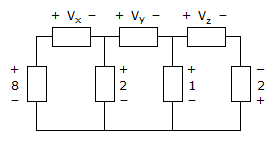
Options- A. Vx = -6 Vy = 3 Vz = -3
- B. Vx = -6 Vy = -3 Vz = 1
- C. Vx = 6 Vy = 3 Vz = 3
- D. Vx = 6 Vy = 1 Vz = 3
- Correct Answer
- Vx = 6 Vy = 1 Vz = 3
ExplanationApply Mesh analysis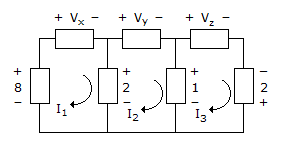
Apply KVL to mesh 2
-2 + Vy + 1 = 0
? Vy = 1
Apply KVL to mesh 1
? -8 + Vx + 2 = 0
? Vx = 6 V
Apply KVL to mesh 3
-1 + Vz -2 = 0
? Vz = 3 V.
Exam Questions Papers problems
Search Results
- 1. In the circuit shown, in switch S is open for a long time and is closed at t = 0. The current i(t) for t ? 0+ is
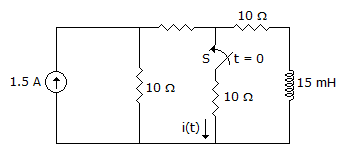
Options- A. i(t) = 0.5 - 0.125e-1000t A
- B. i(t) = 1.5 - 0.125e-1000t A
- C. i(t) = 0.5 - 0.5e-1000t A
- D. i(t) = 0.375e-1000t A Discuss
Correct Answer: i(t) = 0.5 - 0.125e-1000t A
Explanation:
i(f) = 0.5, i(i) = 0.75i(t) = Vr + (ii - ij)e-1/p = 0.5 - 0.125e-1000t .
- 2. Denominator polynomial of a transfer function of certain network is:
s3 + s2 + 2s + 24
Then the network is:
Options- A. stable
- B. oscillatory
- C. unstable
- D. depends on numerator polynomial Discuss
Correct Answer: unstable
Explanation:
Routh array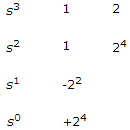
There is negative number present in first column. Thus network is unstable.
- 3. During transmission over a communicate channel, bit errors occur independently with probability
 . If a block of 3 bits are transmitted, the probability of at most one bit error is equal to
. If a block of 3 bits are transmitted, the probability of at most one bit error is equal to
Options- A.

- B.

- C.

- D. none Discuss
Correct Answer: none
Explanation:
Probability of no-error + probability one error
 .
.
- 4. Consider a stable and causal system with impulse response h(t) and system function H(S). Suppose H(S) is rational, contains a pole at S = - 2, and does not have a zero at the origin. The location of all other poles and zero is unknown for each of the following statements. Let us determine whether statement is true or false.
- f[h(t) e-3t] converges

- h(t) has finite duration
- H(s) = H(- s)
Options- A. 1 - True, 2 - False, 3 - True, 4 - False
- B. 1 - False, 2 - False, 3 - False, 4 - True
- C. 1 - False, 2 - False, 3 - False, 4 - False
- D. 1 - True, 2 - can't say, 3 - True, 4 - can't say Discuss
Correct Answer: 1 - False, 2 - False, 3 - False, 4 - False
Explanation:
Statement 1 is false, since f{h(t)e3t} corresponds to the value of the Laplace transform of h(t) at s = 3.If this converges, it implies that s = - 3 is in the ROC.
A casual and stable system must always have its ROC to the right of all its poles. However, s = - 3 is not to the right of the pole at s = - 2.
Statement 2 is false, because it is equivalent to stating that H(0) = 0. This contradicts the fact that H(s) does not have a zero at the origin.
Statement 3 is false. If h(t) is of finite duration, then if its Laplace transform has any points in its ROC, ROC must be the entire s-plane.
However, this is not consistent with H(s) having a pole at s = - 2.
Statement 4 is false. If it were true, then H(s) has a pole at s = - 2, it must also have a pole at s = 2.
This is inconsistent with the fact that all the poles of a causal and stable system must be in the left half of the s-plane.
- 5. A transmission line has a characteristic impedance of 50 ? and a resistance of 0.1 ?/m, if the line is distortion less, the attenuation constant (in Np/m) is
Options- A. 500
- B. 5
- C. 0.014
- D. 0.002 Discuss
Correct Answer: 0.002
Explanation:
Distortion less
a = RG and Z0 = RG ?

 .
.
- 6. The inverse of given Laplace transform is


Options- A. sin t
- B. cos t
- C. et
- D. e2t Discuss
Correct Answer: cos t
Explanation:

s = x2 - ex

x(t) = cos t.
- 7. Consider the common emitter amplifier shown below with the following circuit parameters: ? = 100, gm = 0.3861 A/V, r0 = ? rp = 259 ?, Rs = 1 k?, RB = 93 k?, RC = 250 ?, RL = 1 kW, C1 = ? and C2 = 4.7mF.
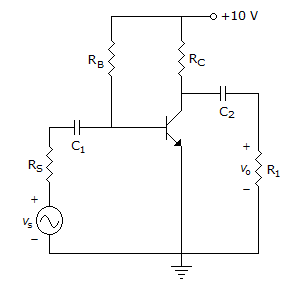
The resistance seen by the source Vs is
Options- A. 258 ?
- B. 1258 ?
- C. 93 k?
- D. ? Discuss
Correct Answer: 1258 ?
Explanation:
Zs = Rs + (RB || Brs)rc = 2.475 = 1.258 kV

- 8. A zener diode is used in
Options- A. voltage regulator circuit
- B. amplifier circuits
- C. both voltage regulator and amplifier circuit
- D. none of the above Discuss
Correct Answer: voltage regulator circuit
Explanation:
Zener diode is used only in voltage regulator circuits.- 9. In an n-p-n transistor, the majority carriers in the base are
Options- A. electrons
- B. holes
- C. both holes and electrons
- D. either holes or electrons Discuss
Correct Answer: electrons
Explanation:
Emitter is n type and emits electrons which diffuse through the base.- 10. In p-n-p transistor the current IE has two components viz. IEP due to injection of holes from p-region to n-region and IE due to injection of electrons from n-region to p-region. Then
Options- A. IEp and IEn are almost equal
- B. IEp >> IEn
- C. IEn >> IEp
- D. either (a) or (c) Discuss
Correct Answer: IEp >> IEn
Explanation:
Emitter is p-type in p-n-p transistor.Therefore holes are majority carriers.
Comments
There are no comments.
More in Electronics and Communication Engineering:
Programming
Copyright ©CuriousTab. All rights reserved.
- 1. In the circuit shown, in switch S is open for a long time and is closed at t = 0. The current i(t) for t ? 0+ is
